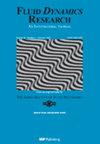基于旋转矢量的通道流湍流结构分析采用大涡模拟模拟
IF 1.3
4区 工程技术
Q3 MECHANICS
引用次数: 0
摘要
即使使用现代测量技术和直接数值模拟(DNS)的数据,由于壁面流中涡流的多尺度性质,也很难识别单个附着涡流并了解其动力学行为,这使这些问题成为当前争论的中心。然而,Liutex矢量(简称L),一个同时包含旋转轴和涡流强度信息的旋转矢量场,最近被刘教授的团队开发为涡流的更准确、更清晰的定义。结合传统方法和L方法可以提供关于复杂流动结构的更详细的信息,以及对流动的混合和传输特征的深入了解。我们通过实现基于箱湍流的流入条件,在大涡模拟中模拟了通道流动。在用DNS数据验证结果后,我们使用L等值面及其矢量轮廓来跟踪壁边界湍流中的有序流动结构。基于这些数据,我们用不同的可视化技术观察到了其他作品中描述的许多湍流现象。此外,墙壁上的剪切污染是最严重的,而所有的均方根L分量变化都可以忽略不计。由于背景剪切的存在,涡度波动的峰值位置比相应的L波动更靠近壁面,并且剪切污染引起的峰值位置位移在涡度波动展向分量(z分量)中最大。根据L分量的两点相关性,湍流结构的顺流尺寸随y+变化不大,但湍流结构的展向尺寸随着y+的增加而逐渐增加。本文章由计算机程序翻译,如有差异,请以英文原文为准。
Rotational vector-based analysis of turbulent structures in channel flow using large eddy simulation simulation
Even with modern measurement techniques and data from direct numerical simulation (DNS), it is very difficult to identify the individual attached eddies and understand their dynamical behavior due to the multi-scale nature of the eddies in wall-bounded flows, which puts these issues at the center of the current debate. However, Liutex vector ( L for short), a rotational vector field with information on both the rotation axis and swirling strength, has recently been developed by Prof. Liu’s group as a more accurate and clear definition of a vortex. Combining conventional and L methods may provide more detailed information about the complex flow structures as well as insights into the flow’s mixing and transport features. We simulated the channel flow in large eddy simulation by implementing an inflow condition based on the box turbulence. After validating the results with DNS data, we used L isosurfaces and their vector profiles to track ordered flow structures in wall-bounded turbulence. Based on the data, we observe numerous turbulent phenomena that have been described in other works with different visualization techniques. Moreover, the shear contamination on the wall is the most severe while all the root-mean-square L component variations are negligible. Due to the presence of background shear, the peak location of vorticity fluctuation is closer to the wall than the corresponding L fluctuation, and the displacement of peak location brought on by shear contamination is greatest for the spanwise component (z-component) of the vorticity fluctuation. According to the two-point correlation of L components, the streamwise size of turbulent structures does not vary considerably with y+ , however, the spanwise size of turbulent structures increases gradually as y+ increases.
求助全文
通过发布文献求助,成功后即可免费获取论文全文。
去求助
来源期刊

Fluid Dynamics Research
物理-力学
CiteScore
2.90
自引率
6.70%
发文量
37
审稿时长
5 months
期刊介绍:
Fluid Dynamics Research publishes original and creative works in all fields of fluid dynamics. The scope includes theoretical, numerical and experimental studies that contribute to the fundamental understanding and/or application of fluid phenomena.
 求助内容:
求助内容: 应助结果提醒方式:
应助结果提醒方式:


